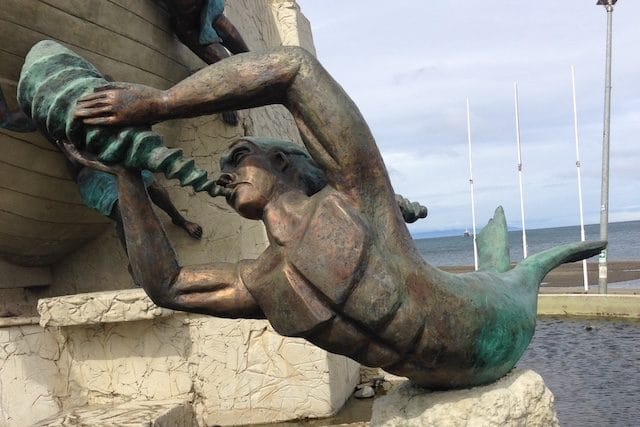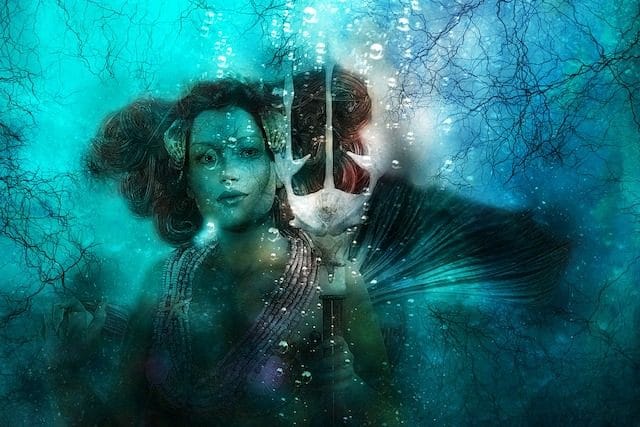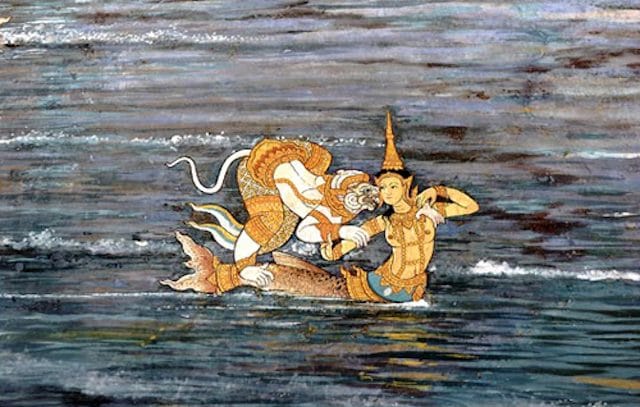For thousands of years, people have been writing about mermaids, and they are still incredibly popular in modern-day movies and TV series. Virtually every culture had their own versions of the mermaid legend. Sometimes, they are sirens who try to lure men to their death out at sea. Other times, they are trying their best to be friendly, and they may even want to become human.
Today, almost everyone has come to an agreement that mermaid sightings in ancient times were most likely a figment of sailors’ imaginations, or misidentifying manatees, seals, and dolphins. However, that doesn’t make it any less fascinating to know exactly what sort of mermaid legends exist throughout the world.
10. Ceasg

The “Ceasg” (pronounced “kee-ask”) mermaid from the Scottish Highlands is half woman, and half salmon. Legend has it that if a sailor can capture a Ceasg, they will get three wishes. They were known for luring men to their deaths, like most siren legends. If you got on a mermaid’s bad side, the only way to kill it would be to destroy their, well… horcrux, for lack of a better word. Just like Voldemort, they put their soul in an object like a shell, and hid it away to ensure that humans could never kill them.
If a sailor succeeded in finding true love with a mermaid, she would transform into a human woman and walk on land. Instead of just three wishes, he will be granted good luck for the rest of their lives. Some Scottish families even claimed that their family descended from a mermaid-human couple.
9. The Chilean Royal Family of the Sea

In Chile, the mythological king of the sea was called Millalobo, who was half man, half sea lion. Unlike most mermaid legends where these creatures just magically come into existence, he was, unfortunately, a product of a human mother and a sea lion father. In case you had any doubts – yes, there is furry fanart of Millalobo everywhere. Don’t worry. It gets worse.
Millalobo married a human woman, and they had a son named Pincoy, and two daughters, named Sirena and Pincoya. Sailors describe seeing the merman Pincoy when they were lost out at sea, and he helped to bring them back to shore. His sister, Pincoya, had long blonde hair and blue eyes. The stories describe her as being the most beautiful woman in the world. She sits on a rock, and dances. If she faces towards the sea, it means the fishermen will find a lot of fish that year. If she faces the shore, it means they will struggle to find food.
Just like many ancient royal families, they didn’t exactly have many options when it came to continuing the mermaid gene pool. Not to get too Game of Thrones here, but Pincoy and Pincoya aren’t just brother and sister… they’re also husband and wife. According to one account from 1632, Pincoya was spotted emerging from the sea holding a baby.
8. Triton

You will probably recognize the name Triton as Ariel’s father in The Little Mermaid. Disney borrowed this character from Greek mythology of the god of Lake Tritonis. Triton was the son of Poseidon, and he carried a conch shell that he could use as a horn, as well as his magic trident.
According to legend, sailors got lost on the lake, and Triton helped them by creating a plot of land, which is now called the island of Thera. The sailors were able to rest while Triton explained to them how to get back to the open sea.
Of course, not all accounts of Triton were positive. When cattle would go missing, or a storm killed sailors out at sea, many assumed that Triton was to blame. People knew that they wouldn’t stand a chance if they tried to go head-to-head with a god, so the best they could do to appease his wrath was leave a chalice of wine for him at the shore as a peace offering.
7. Mami Wata

Mami Wata is an African mermaid goddess who is seen as a compassionate healer, and mother to all aquatic creatures. Stories of her spread all over the continent, and were eventually brought over to the Caribbean islands. There have been sightings of Mami Wata in lakes, rivers, and at the ocean shore. She is often spotted holding a water snake around her shoulders. They say that she can transform into a woman, fish, or a mermaid, depending on her mood.
Today, people are still fascinated with the legend of Mami Wata. Statues and souvenirs of her are sold in gift shops. There is even a religious group called to praise the goddess, where an individual follower is called a “Mami Wata child.” They claim that “Mami Wata” is a name given to the collective of dozens of water deities. Followers claim that they see the mermaid of Mami Wata in their dreams, and it calls them to undergo a spiritual cleansing.
6. The Finfolk

In Scotland and Ireland, they believed in the “finfolk,” which were mermaids who lived in an underwater kingdom called Finfolkenheim. They also took a summer vacation of the island of Hildaland, which would only appear for a moment before disappearing, making it impossible for humans to find. Finfolk were shapeshifters, so they could transform from full fish to full human, or swim around as a mermaid. Stories say that Finfolk men and women were very beautiful, in order to attract humans to mate with them. If they succeeded in finding a human lover, they could suck the youth of out them, and live forever. So, if anyone was kidnapped, or if sailors were lost at sea, it was blamed on the Finfolk, who they believed were captured as sex slaves.
However, if Finfolk married within their own species, the “finwife” was doomed to take on the guise of an elderly woman in order to find work on land to earn silver in order to keep them alive. They described the signs of a “finwife” as an older, unmarried woman who had cats and practiced witchcraft. Obviously, this is just one of the many ways people have tried to accuse lonely old women of being a witches throughout the history of mankind.
5. The Two-Tailed Siren
Have you ever wondered why Starbucks has a two-tailed mermaid as its logo? The original image came from 7th-century Italy. It was one of many illustrations in the Otranto Cathedral in Italy, which is on the shore of the Mediterranean Sea. The mermaid was included next to images of Biblical stories like The Tree of Life, as well as images of the Egyptian Sphinx and Alexander the Great. It was supposed to represent the exchange of religions, philosophies, and ideas that were being exchanged during the Middle Ages. Some believe that it was based on the legend of Melusine, the French water spirit who was said to transform into a human woman, or have fish tails.
Throughout the years, many artists copied the image of the two-tailed siren. Starbucks claims that they were inspired by a 16th century Norse woodcut image of this mermaid. Apparently, the reason why they chose the image as their coffee logo is because they wanted their coffee to be just as seductive as a mermaid.
4. Iara

According to Brazilian legend, Iara was a brave, intelligent girl living in the Amazon. She was a warrior who could fight better than her own brothers. She so well-loved and respected by her community, her brothers’ accomplishments paled by comparison. Their jealousy was so intense that they killed her and dumped her body into the Amazon River. The goddess of the moon, Jaci, felt sorry for her, and brought her back to life as a mermaid.
After becoming a mermaid, Iara spent the rest of her days seeking revenge on men. Any time a man drowned in the river, they blamed it on Iara. Later on, a man named Jaraguari came across Iara, and they fell in love. He told his mother about the beautiful mermaid that he met while fishing on the Amazon river, and he decided to join her in a life underwater. Some believe that since then, her angry spirit was finally at peace.
3. The Jamestown Mermaid

You may remember John Smith from the story of Pocahontas, and his part in colonizing Jamestown, Virginia. During his travels on the sea, he claimed to have seen a beautiful woman with green hair swimming next to the boat. When she dove underwater, he noticed that she was actually a mermaid.
However, this account has been a topic of heated historic debate, with many people believing that John Smith never made this claim at all, and that writers telling the stories of his travels took creative liberties. Even so, this wasn’t the only time travelers colonizing the New World claimed to see mermaids. Today, these sightings are thought to be misidentified manatees.
2. The Dutch Mermaid

In 1403, a dike in the city of Kampen in the Netherlands had a crack in it, opening it up to the sea. Water began to flood into the river. After making repairs, citizens from of Kampen claimed that they saw a mermaid swimming in the river in town. At first, people were scared, but the woman continued to swim without bothering anyone. The people eventually decided to capture this woman and bring her on land, where she transformed into a human with two legs. She could not speak, but they cleaned her up, and forced her to go to church and become a Christian. She attempted to escape and jump into the water multiple times, but someone always stopped her.
Some historians believe that this was a woman who was never a mermaid at all. She was deaf and mute, and she just really liked swimming.
1. Jiaorén

In Chinese folklore, the Jiaoren weren’t just beautiful mermaids. They were very skilled craftspeople who could weave beautiful white cloth called “dragon yarn” that could never get wet. They said that if a mermaid cried, her tears turned into pearls. During the Jin Dynasty, one account tells the story of a mermaid who emerged from the water and decided to sell dragon yarn to humans.
If anyone was kind to her and gave her a place to stay, she would thank them by crying into a jar, filling it with precious pearls. Throughout history, there are several accounts of high-society people claiming that they owned cloth made from a mermaid’s dragon yarn.